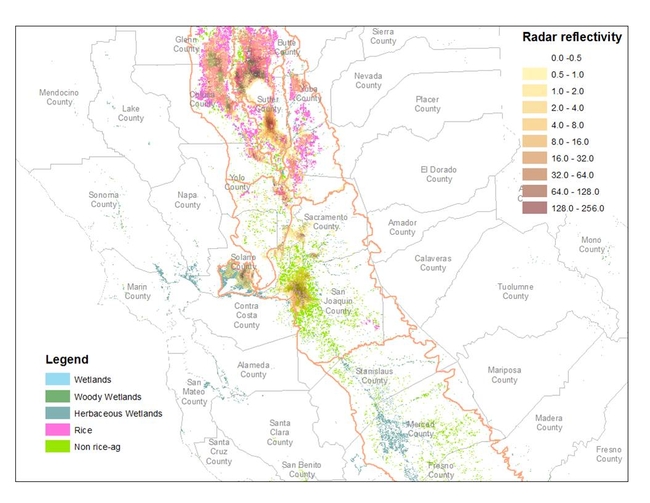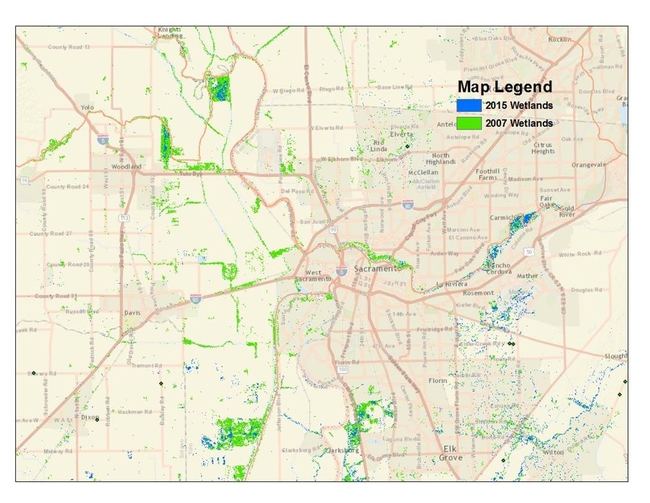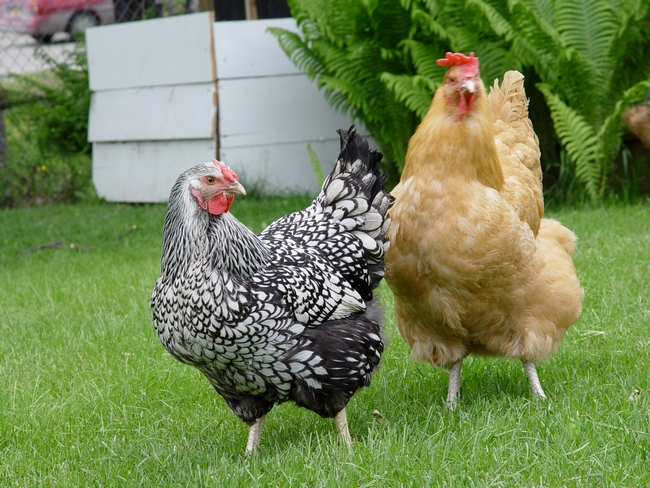Posts Tagged: avian
Weather radar helps researchers track bird flu
The same weather radar technology used to predict rain is now giving UC researchers the ability to track wild birds that could carry the avian influenza virus. Avian influenza, which kills chickens, turkeys and other birds, can take a significant economic toll on the poultry industry. In 2014- 2015, the United States experienced its worst bird flu outbreak in history, resulting in more than 48 million birds dying in 15 states, including California.
“We use the existing network of weather radar stations in the U.S. in the same way that radar is used to track rain, except that we process the data to allow us to interpret the radar signal bouncing off birds instead of raindrops,” said Maurice Pitesky, UC Cooperative Extension poultry specialist. “The data can be interpreted to track birds.”
NEXRAD, or next-generation radar, is a network of 160 high-resolution S-band Doppler weather radars operated by the National Weather Service. The technology works best for tracking birds in the winter during feeding. When waterfowl leave their roosting locations in concert to feed, their bodies produce reflectivity of the radar beam.
“By tracking mass bird movements remotely in real-time, we hope to gain novel strategic insights with respect to surveillance and prevention of avian influenza transmission to domestic poultry,” said Todd Kelman, a veterinarian and engineer who co-leads the project with Pitesky, who is also in the School of Veterinary Medicine at UC Davis. They are exploring how the information might be used to prevent an outbreak.
In California, waterfowl migrate by the millions from September through March via the Pacific Flyway, where they winter in wetlands, rice and corn fields. The Central Valley alone is home to 3 million waterfowl at the height of migration.
“Using NEXRAD and various other approaches, we hope to be able to produce monthly or quarterly maps that will alert poultry producers as to the locations of waterfowl in the Central Valley of California,” Pitesky said.
“Waterfowl populations can have different habitat based on the amount of precipitation in a given year,” said Pitesky. “Therefore, we need to use these types of monitoring tools to understand where waterfowl are located. Landsat, or satellite-based land imagery, and NEXRAD are two remote tools that may be very useful, as opposed to flyovers and banding, which are more expensive and not practical for large geographical areas.”
The project — funded by UC Agriculture and Natural Resources — is a collaboration between UC Davis School of Veterinary Medicine and Jeff Buler, University of Delaware wildlife ecologist whose team first developed the NEXRAD approach in the Central Valley of California. They are also working with the U.S. Geological Survey, the California Department of Food and Agriculture, the California Poultry Federation, the Pacific Egg and Poultry Association and Point Blue, an organization that focuses on conservation science.
Reduce the risk of bird flu in backyard chickens
Protecting their birds against disease should be a priority for chicken owners, no matter what size the flock, according to Maurice Pitesky, a UC Agriculture and Natural Resources Cooperative Extension specialist in the School of Veterinary Medicine at UC Davis.
“Wild birds are the biggest risk because they can carry the virus but look completely healthy, so it's important to keep them away from your chickens,” said Pitesky. He adds that signs your chicken could have contracted avian influenza are depression, no appetite, diarrhea, soft/misshaped eggs, and sudden and increased or unexplained death in flocks.
Commonly called “bird flu,” the avian influenza virus - routinely found in wild waterfowl - can spread to chickens and other domestic poultry and cause significant mortality and economic loss. This year the nation has experienced the worst bird flu outbreak in history, with three confirmed cases in California — two of which carried the more dangerous, highly pathogenic strain. In each case, the disease, which is not dangerous to humans, was introduced by wild waterfowl migrating along the Pacific Flyway. Some of these wild birds might now be carrying the Eurasian strain of the H5 highly pathogenic avian influenza.
Pitesky and the California Department of Food and Agriculture offer some important bioscurity tips to help reduce the risk of your chickens contracting bird flu:
- Wash your hands with soap and water or use hand sanitizer before and after working with chickens.
- Use footbaths before entering and exiting the fenced-off coop area. Each footbath — a covered container with an approved disinfectant to disinfect shoes — should be placed in a staging station, such as on a concrete surface or a pallet, to prevent dirt from being tracked into the footbath. Disinfectant should be changed daily to be effective.
- Have designated “coop boots.” These will be the only shoes that go into your chicken area, and they won't go anywhere else. If you hunt waterfowl, make sure your equipment and clothing are separate from your domestic poultry.
- Don't allow wild animals and waterfowl to come in contact with your chickens. For example, if you have a pond or body of water that can attract waterfowl to or near your facility, consider draining if feasible.
- When obtaining birds, isolate them from other birds for 30 days before adding them into your flock. This will reduce the risk of introducing disease into the original flock.
- Always obtain birds from reputable, disease-free sources that practice good biosecurity methods, and purchase feed from clean, dependable suppliers. Store the feed in containers that are bird, rodent, and insect proof. Provide clean, fresh water to your birds at all times.
- Restrict access by visitors onto the premises where your birds are housed. Do not allow people who own other birds to come in contact with your birds.
- Report signs of illness or increased mortality to your veterinarian or the Sick Bird Hotline 866-922-BIRD (2473). In addition, necropsies are provided free-of-charge for owners of less than 1,000 chickens at the school's California Animal Health and Food Safety Laboratory System.
By joining the California Poultry Census, you can receive the latest information and updates about avian influenza in California.
Early disease detection, prevention key to limiting spread of disease
State officials credit early disease detection and prevention, through proactive surveillance and good biosecurity practices, as key factors limiting the spread of avian influenza. For example, a wildlife surveillance program conducted by USDA Wildlife Services regularly submits samples to the veterinary school's California Animal Health and Food Safety Laboratory System at UC Davis for testing. This helps scientists and animal health officials understand where certain viruses are circulating in the U.S., including the more dangerous strains for domestic poultry.
UC poultry experts are conducting a statewide survey of backyard chickens, and providing outreach and training on health and disease prevention to individuals who, in turn, will provide the information to backyard chicken producers and small, commercial chicken operations. In addition, veterinary researchers Rodrigo Gallardo and Beate Crossley have recently been awarded a grant to study new, highly pathogenic viruses affecting the U.S. poultry industry. The goal is to better understand why these viruses have been so difficult to eradicate and to help prevent their introduction to commercial farms.
Additional information:
- University of California Cooperative Extension Poultry Resources
- CDFA Backyard Biosecurity for Poultry
- USDA Backyard Biosecurity
Some people may already have immunity to H1N1
New research by a UC Davis scientist and a UC Cooperative Extension specialist has found that some senior citizens already have a level of immunity to H1N1 flu, formerly known as Swine flu. The finding may explain why the 2009 H1N1-related symptoms have been generally mild, according to a UC Davis news release distributed to the media yesterday."The more you're exposed to viruses that can stimulate all types of immune response, the better protected you're likely to be," the Sacramento Bee quoted UCCE specialist and study co-author Carol Cardona in a story about the findings. "There does seem to be some level of antibody protection that people over 65 seem to have. There are some good things about getting older."
The scientists identified structural sites on the H1N1 virus that are also present in seasonal flu viruses that have been circulating for years. Many people over 60, who were likely exposed to similar viruses earlier in life from flu exposure or vaccinations, carry antibodies or another type of immunity against the new virus.
The study's authors, Cardona and project scientist Zheng Xing, are both associated with the UC Davis School of Veterinary Medicine. The news release says their study has implications for avian influenza.
About 80 percent of the epitopes - the structural sites on the virus - found in seasonal influenza and flu vaccine viruses are also present in the avian influenza virus. The scientists suggest that these epitopes may have protected some individuals infected with the avian flu virus through cytotoxic T-cell immunity.
Xing and Cardona's findings will appear in the November edition of Emerging Infectious Diseases, a journal published by the Centers for Disease Control and Prevention.

Drs. Xing and Cardona





